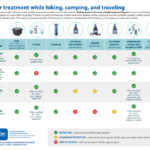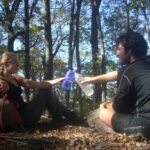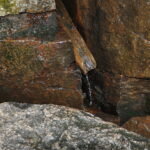Water on the Trail
Water faucets, pumps, or spigots are rare on the Appalachian Trail (A.T.).
Reliable, natural water sources are where most hikers fill up and listed in guidebooks and the FarOut app. Springs and streams are marked on most official A.T. maps. Most, but not all, shelters are near a reliable water source. Keep in mind that some springs and streams dry up during late summer and early fall, especially those marked as seasonal, so plan carefully.
Water Safety and Treatment
Water in the backcountry and along the Trail may be clear, cold and free-running, and may look, smell and taste good. However, these sources can still be contaminated by microorganisms, including Giardia lamblia and others that can cause diarrhea or stomach problems. Always treat and/or filter water on the A.T. before using it for drinking, cooking, or cleaning.
Visit the Centers for Disease Control and Prevention page on healthy water for detailed information on water treatment methods and their effectiveness in removing pathogens, and information on less common treatment methods not listed below.
Download Water Treatment PDF
How Much Water Should You Carry?
We recommend having the capacity to carry at least two liters of water, but how much water you carry at any given time depends on how far you plan to hike, how far until the next water source, and current conditions.
Your own preference and needs also come into play. For example, some folks sweat more than others, so they need to carry more water to replace those fluids.
Water for Day Hikes
- If you are out for a day hike and plan to be out for 1 to 5 miles in cool to warm weather on mild to moderate terrain, you may only need 1 liter of water.
- If you are out for a day hike and plan to hike further than 5 miles, it’s hot out, and/or you will be in rugged terrain, you will likely want to carry more than 1 liter of water.
- Day hikers should consider carrying a lightweight filter or chemical treatment so they can get more water while on the Trail, especially on extended day hikes or in hot weather.
Visit our A.T. Hike Rating Scale for more information and recommendations about how much water to carry.

Water for Backpacking
- Have the ability to carry at least two liters of water, either in bottles, in a hydration pack, or a combination of both.
- Seasonal creeks and springs on the A.T. tend to dry up in late June through September. Other sources can dry up during drought in the summer and fall. Contact the ATC or the local A.T. Club ahead of your hike to ask about recent water source conditions.
- Carry more water in hot weather and in rugged terrain, or if there is over 5 miles between water sources.
- Do not rely on water caches. They may be empty when you arrive.
- Ask hikers you meet who are hiking in the opposite direction about water sources ahead.

How to Get Updated Information About Water Sources
More hikers are finding that A.T. water sources go dry in the summer and fall. This is especially true for any sources labeled as “seasonal” in guidebooks and in the Mid-Atlantic region (WV – NY). Luckily, there are a few ways to find updated information about water sources along the A.T.
- Consult crowd-sourced information like FarOut comments. Especially during peak thru-hiker season, the comments in FarOut are almost real-time updates.
- Consult the local A.T. maintaining Club. Chances are a section or shelter maintainer was out recently and checked the water source. You can find A.T. Clubs by turning on the A.T. Club layer in our interactive map or visiting our Clubs & Partners page.
- Call the local land manager (U.S. Forest Service, National Park Service, state park, etc.)
And you can always contact us! We are happy to help find the latest information and, if we don’t have it, we can point you to the right A.T. Club or land manager.

Laurie Potteiger




